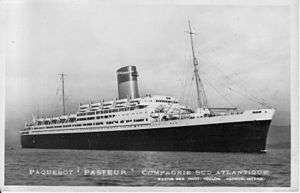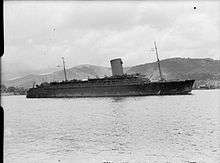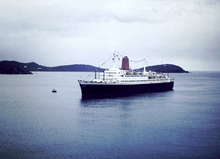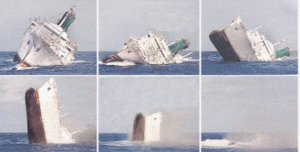SS Pasteur (1938)
 SS Pasteur | |
| History | |
|---|---|
| Name: |
|
| Namesake: | |
| Owner: |
|
| Operator: |
|
| Port of registry: | |
| Route: |
|
| Builder: | Chantiers de l'Atlantique[1] |
| Yard number: | R8[1] |
| Launched: | 15 February 1938[1] |
| Christened: | February 15, 1938 by Madame Pasteur Vallery-Radot, wife of the grandson of Louis Pasteur[1] |
| Completed: | August, 1939[1] |
| Commissioned: | 1940 |
| Decommissioned: | 1980 |
| Out of service: |
|
| Refit: |
|
| Identification: |
|
| Honours and awards: | Croix de Guerre |
| Fate: | Sank in Indian Ocean in 1980 while being towed to Taiwanese ship breakers.[1] |
| General characteristics | |
| Type: |
|
| Tonnage: | |
| Length: | 212.4 m (696 ft 10 in)[1] |
| Beam: | 26.8 m (87 ft 11 in)[1] |
| Decks: | 11 decks |
| Installed power: | Three 1,375 KVA generator had an output of 6,600 Kilowatt. |
| Propulsion: |
|
| Speed: |
|
| Capacity: | |
| Crew: | 540 (Pasteur)[1] |
SS Pasteur was a turbine steam ship built for Compagnie de Navigation Sud-Atlantique. She later sailed as Bremen for Norddeutscher Lloyd. In the course of her career, she sailed for 41 years under four names and six countries' flags.[1]
Construction
In 1936 the French shipping company Compagnie de Navigation Sud-Atlantique planned to order a new ship to carry passengers and freight on their South Atlantic routes. Her main competition was the German liner Cap Arcona owned by the Hamburg Südamerikanische Dampfschifffahrts-Gesellschaft. Building began in 1938 at Chantiers de l'Atlantique, in Saint-Nazaire, France. On 15 February 1938, she was christened Pasteur after the scientist Louis Pasteur. A fire in March 1939 delayed her fitting out and she was not completed until August 1939, just before World War II broke out.[1][3]
Pasteur was 29,253 gross tons. She was 212.4 m long and 26.8 m wide. She had 11 decks and possessed extensive loading spaces. She was designed to carry 751 passengers. She could reach around 50,000 HP and speeds up to 26 Knots, but her usual service speed was around 22 knots, making her the third fastest ship of her time. Her draft was 9.3 m. She had four propellers.
History
The outbreak of World War II delayed the deployment of Pasteur, and she was laid up in Saint-Nazaire in France. In 1940 she was commissioned to carry 200 tons of gold reserves from Brest, France to Halifax, Nova Scotia. Her official maiden voyage from Bordeaux to Buenos Aires was cancelled due to the outbreak of war. After the fall of France, she was taken over by the Great Britain government and placed under Cunard-White Star management. She was used as a troop transport and military hospital ship between Canada, South Africa, Australia and South America, and transported around 300,000 soldiers. She was sometimes called HMTS Pasteur.[1][3]
World War II

Due to her speed the Pasteur normally made her crossings alone and unescorted rather than as part of a convoy. She made one voyage from Glasgow to Halifax with a mixed complement of troops, including officers arranging the transport of 20,000 British troops across Canada and the Pacific to Singapore in October, 1941. The Pasteur also carried almost 2,000 German prisoners to prisoner of war camps in North America. In addition, she transported prisoners from Suez, Egypt to South Africa. She visited Freetown, Cape Town, Durban, Aden and Port Tewfik, and then back to the Clyde and Halifax in 1943. She carried 10,000 troops of the British 8th Army Corps and 5,000 US 1st Army Corps troops to the battle of Alamein. Altogether she carried 220,000 troops, and 30,000 wounded, and traveled 370,669 miles during the war.[1][3]
Post-war
After the war she was used to repatriate US and Canadian troops then returned to her owners in October 1945. Management was returned to Cie Sudatlantique in early 1946. After her return to France in 1946 she remained in French military service as troop transporter. She carried French troops to Vietnam (Vietnam War), and then to Algeria between 1954 and 1957. She was awarded France's highest honor, the Croix de Guerre. She made one voyage bringing 4,000 Dutch troops from Indonesia to The Netherlands in February 1950.[1][3]
Acquired by North German Lloyd
She was laid up at Toulon in 1956 and then at Brest in 1957. During the Suez Canal affair, the ship was activated again in September 1956 along with other passenger and military ships to be a troop transport. While she was docked in Port Said harbor in December 1956 the HQ General of the French troops was on board. At the end of the war, Pasteur was one of the last Allied ships to leave Port Said. She was sold to North German Lloyd for 30 millions DM in September 1957. The sale sparked violent protests in France. The transfer of ownership from Brest to Bremerhaven took place in September 1957.
Refit
After she was acquired by North German Lloyd and renamed TS Bremen in 1957, she was extensively rebuilt at Bremer Vulkan in Bremen for approximately 65 millions DM. Her size was increased to 32,336 GRT and the load-carrying capacity with 8,700 tdw. She received new boilers and four steam turbines with a maximum output of 60,000 HP rendering a maximum speed of 26 knots. Economical output of 53,500 HP gave a useful speed of 23 knots. Three 1,375 KVA generators had an output of 6,600 kilowatt. One very noticeable change was the new drop-shaped funnel, which was much more in proportion with the ship than the original tall funnel. To enhance comfort, two 4.5 m Stabilizers were fitted. In June 1959 she underwent new sea trials.[1][3]
German service

On July 9, 1959, she was placed on the Bremerhaven – Southampton – Cherbourg – New York City route. In 1960, Bremen carried approximately 28,000 passengers across the Atlantic from Europe to the USA and back again. Beginning in 1960, the Bremen was also used in cruise service to the Caribbean and South America. A bulbous bow was added during her 1965–66 refit at the repair yard of North German Lloyd. In 1970, NDL merged with Hamburg America Line to form the large shipping company, Hapag Lloyd. In September 1971, she made her final voyage from Bremen to New York for Hapag-Lloyd. In October 1971, Bremen was sold to Greek shipping company Chandris Cruises for 40 millions DM after 175 Atlantic crossings and 117 cruises for NDL. The sale was completed in January, 1972.[1][3]
Other services and fate
After another refit, which changed her tonnage to 23,801 tons, the TSS Regina became the flagship of Chandris Cruises and inaugurated her Mediterranean service, calling at Limassol for the first time on May 19 and taking passengers from Cyprus to Beirut, Haifa, Heraklion, Piraeus, Katakolon, Corfu, Dubrovnik and Venice. Regina continued calling at Limassol regularly every two weeks and her cruises became extremely popular.
She cruised the world until 1974, when she was laid up in Piraeus because of rising fuel costs and the loss of emigration charters to Australia.

She was sold to Philippine Singapore Ports Corporation of Saudi Arabia and renamed Saudiphil I in 1977. On November 1, 1977 she arrived at Jeddah to be used as an accommodation ship for Filipino workers in Saudi Arabia.
In 1980 she was sold to the Philsimport International in Hong Kong and renamed Filipinas Saudi I. She rolled over onto her port side and sank stern first in the Indian Ocean that same year while being towed by the Panamanian tug Sumatra to Taiwanese ship breakers in Kaohsiung, Taiwan.[1][3]
Crew and passengers
TS Bremen had a total crew complement of 545, with three hundred crew members in the hotel department. She could carry approximately 1,150 passengers, 216 in first class and 934 in tourist class.[4]
Captains of Bremen:[4]
- Heinrich Lorenz (1959–60)
- Fritz Leusner (1960)
- Günter Rössing (1960–65)
- Heinrich Behnsen (1965–69)
- Walter Bulkhead (captain agencies around 1969)
- Paul Vetter (1969–71)
- Claus Hamje (1971–72)
Official numbers and code letters
Official numbers were a forerunner to IMO Numbers. Pasteur had the UK official number 166305 and used the code letters FNDC until 1940 and GNDW from 1940–46.[2]
Further reading
- Britton, Andrew (2015). SS Pasteur/TS Bremen. Classic Liners series. Stroud, Gloucestershire: The History Press. ISBN 9780750961011.
- Focke, Harald, Bremens letzte Liner. Die großen Passagierschiffe des Norddeutschen Lloyd nach 1945. Publishing house, Bremen 2002, ISBN 3-89757-148-X
- Focke, Harald, Mit dem Lloyd nach New York Erinnerungen an die Passagierschiffe Berlin, Bremen und Europa. Publishing house, Bremen 2004, ISBN 3-89757-251-6
- Focke, Harald, Im Liniendienst auf dem Atlantik. Publishing house, Bremen 2006, ISBN 3-89757-339-3
References
- 1 2 3 4 5 6 7 8 9 10 11 12 13 14 15 16 17 18 19 20 21 22 23 Complete History of Pasteur
- 1 2 "Lloyd's Register, Steamers & Motorships" (PDF). Retrieved 26 October 2009.
- 1 2 3 4 5 6 7 Bremen at Greatships.net
- 1 2 Dirk, J. Peters (Hrsg.): Der Norddeutsche Lloyd. Hauschild Verlag, Bremen 2007, ISBN 978-3-89757-360-4
External links
- Bremen at Simplon Postcards
- Takis Solomonides Autobiography
- The TSS Pasteur… a Great Ocean Liner that was Officially Never in Service…
Coordinates: 07°35′N 60°12′E / 7.583°N 60.200°E